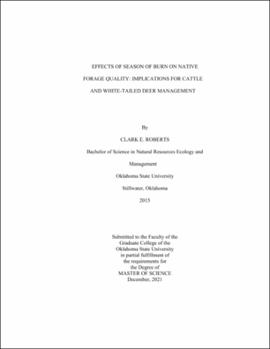| dc.contributor.advisor | Hickman, Karen R. | |
| dc.contributor.author | Roberts, Clark E. | |
| dc.date.accessioned | 2022-05-13T19:05:20Z | |
| dc.date.available | 2022-05-13T19:05:20Z | |
| dc.date.issued | 2021-12 | |
| dc.identifier.uri | https://hdl.handle.net/11244/335788 | |
| dc.description.abstract | Previous research has examined the benefits of fire and its ability to alter the nutrient quality of forages. Fire increases forage quality, but is largely based upon composite forage samples or on fire removing older, lower quality forage encouraging regrowth that is more palatable and higher in quality. Few studies have evaluated the effect of fire on individual plant species and their changes in nutrient quality following season of burn and how that contributes to meeting animal nutrient requirements. In this study I evaluated the changes in nutrient composition (i.e., protein and total digestible nutrients (TDN)) of (Ambrosia spp.), croton (Croton spp.), slender lespedeza (Lespedeza virginica (L.) Britton), buckbrush (Symphoricarpos orbiculatus Moench), greenbriar (Smilax spp.), little bluestem (Schizachyrium scoparium var. scoparium (Michx.) Nash) and Scribner's panicum (Dichanthelium oligosanthes var. scribnerianum (Nash) Gould) (ITIS. 2020) following dormant (April 2019) and growing (July 2019) season prescribed fire within a patch burn grazing system to aid in management decisions for cattle and white-tailed deer. I hypothesized that burning in multiple seasons (i.e., dormant and growing season) will increase and extend forage quality over some period of time, creating higher quality forage for cattle and white-tailed deer across a longer portion of the year. In this study, dormant and growing season prescribed fire did improve forage quality (i.e. crude protein, TDN) of the 7 studied plant species helping to meet the animal nutrient requirements. There was not any evidence to suggest that the incorporation of both dormant and growing season burns will extend the amount of time forage quality will meet animal needs with the exception of little bluestem (Schizachyrium scoparium). Findings from this study will aid in the management and understanding of how different season of burns affect nutrient quality of commonly utilized forages of both cattle and deer. These results indicate that careful considerations need to be made when determining when, if, and how to implement burns; because each season of burn has its pros and cons when managing for cattle and white-tailed deer simultaneously. | |
| dc.format | application/pdf | |
| dc.language | en_US | |
| dc.rights | Copyright is held by the author who has granted the Oklahoma State University Library the non-exclusive right to share this material in its institutional repository. Contact Digital Library Services at lib-dls@okstate.edu or 405-744-9161 for the permission policy on the use, reproduction or distribution of this material. | |
| dc.title | Effects of season of burn on native forage quality: Implications for cattle and white-tailed deer management | |
| dc.contributor.committeeMember | Webb, Stephen L. | |
| dc.contributor.committeeMember | Goodman, Laura E. | |
| osu.filename | Roberts_okstate_0664M_17425.pdf | |
| osu.accesstype | Open Access | |
| dc.type.genre | Thesis | |
| dc.type.material | Text | |
| dc.subject.keywords | animal nutrient requirements | |
| dc.subject.keywords | fire | |
| dc.subject.keywords | season of burn | |
| thesis.degree.discipline | Natural Resource Ecology and Management | |
| thesis.degree.grantor | Oklahoma State University | |
